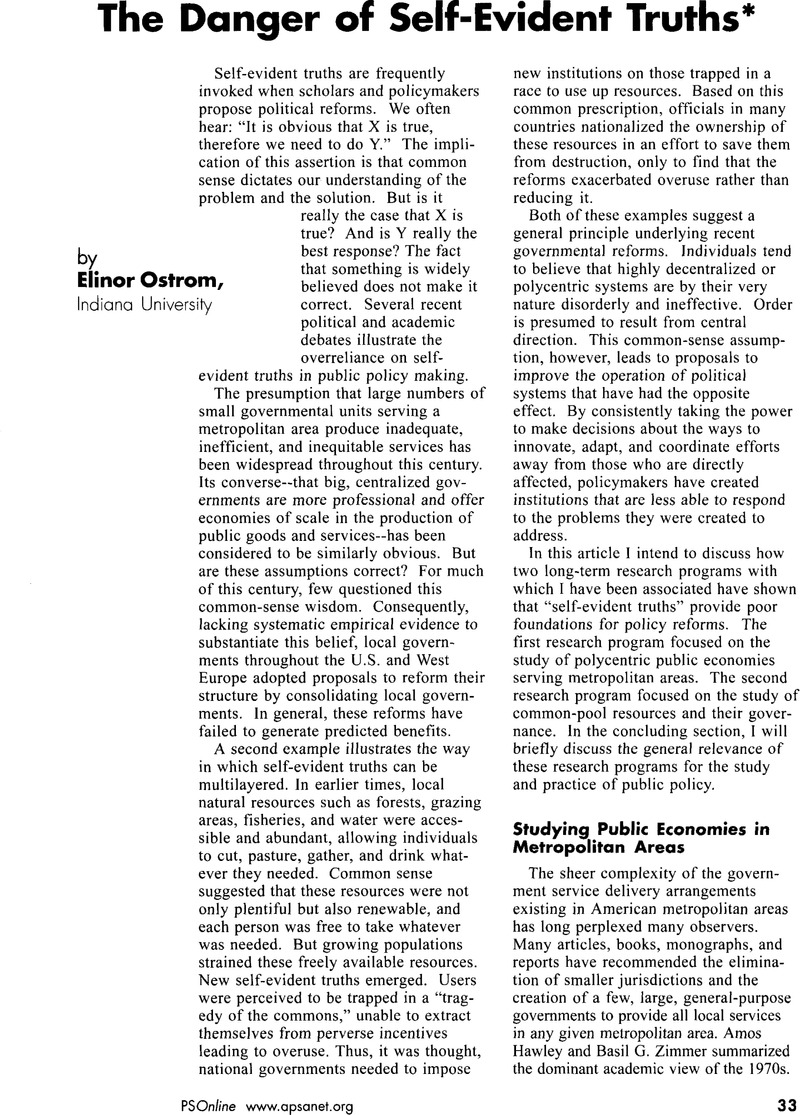Crossref Citations
This article has been cited by the following publications. This list is generated based on data provided by
Crossref.
Bainbridge, W.S.
2003.
The future in the social sciences.
Futures,
Vol. 35,
Issue. 6,
p.
633.
Desbiens, Jacques
2003.
L'éternel compromis entre l'équité et la performance en administration publique appliqué au monde municipal.
Gestion,
Vol. Vol. 28,
Issue. 3,
p.
13.
Dedeurwaerdere, Tom
2004.
Bioprospection: From the Economics of Contracts to Reflexive Governance.
SSRN Electronic Journal,
Janiskee, Brian P.
2004.
The Structure of American Local Government.
Perspectives on Political Science,
Vol. 33,
Issue. 2,
p.
89.
Dedeurwaerdere, Tom
2004.
Bioprospection: From the Economics of Contracts to Reflexive Governance.
SSRN Electronic Journal,
Theesfeld, Insa
2004.
Constraints on Collective Action in a Transitional Economy: The Case of Bulgaria’s Irrigation Sector.
World Development,
Vol. 32,
Issue. 2,
p.
251.
Heikkila, Tanya
2004.
Institutional boundaries and common‐pool resource management: A comparative analysis of water management programs in California.
Journal of Policy Analysis and Management,
Vol. 23,
Issue. 1,
p.
97.
Avery, George
2004.
Bioterrorism, Fear, and Public Health Reform: Matching a Policy Solution to the Wrong Window.
Public Administration Review,
Vol. 64,
Issue. 3,
p.
275.
Perez, Oren
2004.
Global Legal Pluralism and Electronic Democracy.
SSRN Electronic Journal,
Bearfield, Domonic
2006.
American Public Service.
Vol. 20064555,
Issue. ,
p.
101.
Justice, Jonathan B.
2006.
Social Construction of Rational Self-Interest: The Case of Business Improvement Districts.
SSRN Electronic Journal,
Briggs, David
and
Stern, Richard
2007.
Risk Response to Environmental Hazards to Health – Towards an Ecological Approach.
Journal of Risk Research,
Vol. 10,
Issue. 5,
p.
593.
Wills-Johnson, Nick
2008.
Railway Dreaming: Lessons for Economic Regulators from Aboriginal Resource Management Lore.
SSRN Electronic Journal,
Yang, Lihua
and
Wu, Jianguo
2009.
Scholar-participated governance as an alternative solution to the problem of collective action in social–ecological systems.
Ecological Economics,
Vol. 68,
Issue. 8-9,
p.
2412.
Schlager, Edella
and
Heikkila, Tanya
2009.
Resolving Water Conflicts: A Comparative Analysis of Interstate River Compacts.
Policy Studies Journal,
Vol. 37,
Issue. 3,
p.
367.
Theesfeld, Insa
2010.
Institutional Challenges for National Groundwater Governance: Policies and Issues.
Groundwater,
Vol. 48,
Issue. 1,
p.
131.
Wills‐Johnson, Nick
2010.
Railway Dreaming: Lessons for Economic Regulators from Aboriginal Resource Management Lore.
Review of Policy Research,
Vol. 27,
Issue. 1,
p.
47.
Schrank, A.
2011.
Co-producing workplace transformation: the Dominican Republic in comparative perspective.
Socio-Economic Review,
Vol. 9,
Issue. 3,
p.
419.
Aldrich, Daniel P.
2011.
The Externalities of Strong Social Capital: Post-Tsunami Recovery in Southeast India.
Journal of Civil Society,
Vol. 7,
Issue. 1,
p.
81.
Keefer, Philip
2011.
Collective Action, Political Parties, and Pro-Development Public Policy.
SSRN Electronic Journal,
